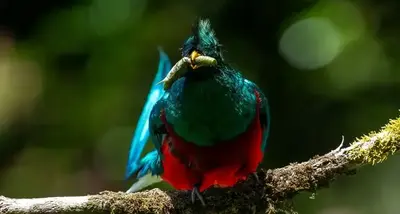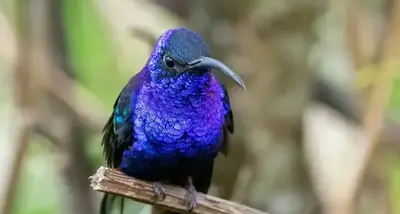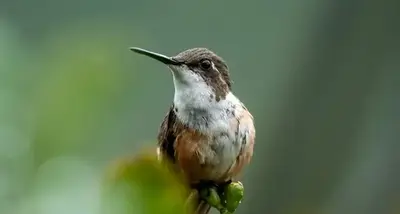Mount Totumas Cloud Forest
Ecolodge & Preserve
- 400 acres of protected secondary and primary cloud forest
- 24 hour access to 30 km of trails
- Access to bordering La Amistad International Park
- One of the best places to view resplendent quetzals, bellbirds, and montane pitvipers
Table of Contents
Mount Totumas Ecolodge
Mount Totumas Ecolodge is a remote eco-lodge and private nature reserve located in the highlands of western Panama, near the border of La Amistad International Park. Set at 1,900 meters elevation on a 400-acre property, it protects a mosaic of regenerating cloud forest and ancient old-growth trees—habitats that support an extraordinary diversity of wildlife. Mount Totumas offers 24-hour trail access, comfortable accommodations, and expert-guided or self-guided exploration, making it a top destination for birders, herpetologists, and wildlife photographers. Visitors can encounter iconic species like the resplendent quetzal, three-wattled bellbird, and montane pitvipers. Although off the grid, the lodge provides reliable electricity, Wi-Fi in shared areas, and a full-service restaurant that sources fresh produce from its on-site gardens.
About Mount Totumas Ecolodge and Cloud Forest Preserve

Mount Totumas Ecolodge is more than just a destination—it’s part of a growing model of conservation-driven ecotourism. Located in the Talamanca Highlands of western Panama, the lodge sits on a 400-acre private reserve that directly borders La Amistad International Park, a UNESCO World Heritage Site, spanning two countries, Costa Rica and Panama, and is the largest protected highland forest in Central America. Through the work of its founder Jeffrey Dietrich, the reserve has become both a sanctuary for biodiversity and a living example of how private landowners can protect and restore valuable ecosystems through sustainable tourism.
A Vision for Conservation and Ecotourism
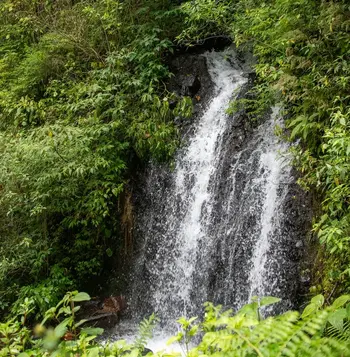
Mount Totumas was founded in 2008 by Jeffrey Dietrich, a lifelong naturalist with a background in ecology and a passion for birdwatching that began in childhood. After years spent traveling through Latin America for work and combining business trips with visits to ecolodges, Jeffrey began to envision a project of his own—one that would merge his ecological values with a sustainable livelihood rooted in wilderness preservation.
When he discovered the Mount Totumas property—a mix of overgrazed pasture and intact cloud forest—it immediately stood out for its location and potential. With the goal of creating a nature reserve that could also serve as an ecolodge, Jeffrey and his family began the long process of restoring the land, building accommodations, and establishing infrastructure for off-grid living powered by a micro-hydro system. Over the past 15 years, the property has undergone extensive reforestation, with native trees reclaiming former pastures and creating critical habitat corridors that connect to the vast wilderness of La Amistad National Park.

Today, the ecolodge provides an immersive, low-impact experience for travelers seeking meaningful encounters with nature. Visitors contribute directly to the long-term protection of the reserve and the surrounding wilderness by supporting a business that makes conservation financially viable.
Location & Elevation: Gateway to La Amistad Park
Mount Totumas sits at approximately 1,900 meters elevation, in the heart of the mid- to upper-elevation cloud forest ecosystem. This unique habitat is known for its lush vegetation, cool temperatures, high humidity, and high levels of endemism. While much of the forest on the property is secondary, it has been protected for decades and now supports a vibrant and complex structure, including large old-growth trees that survived past logging and agriculture.
Epiphytes—orchids, bromeliads, mosses, and even epiphytic blueberries—cover the trees in dense, hanging gardens. Streams, ridgelines, and transitional zones between habitats provide microclimates that support a wide range of species, from rare amphibians and reptiles to iconic birds of the Talamanca highlands. Because the reserve borders over a million acres of protected land, it functions as an important buffer zone and wildlife corridor, offering guests the chance to observe species that would otherwise be difficult to access outside of the park itself.
Birding Mount Totumas

Birdwatchers from around the world visit Mount Totumas for its exceptional birding opportunities. More than 260 species have been recorded on the reserve, with over 290 documented in the area, including along the public access road. The reserve is particularly well known for its reliable sightings of resplendent quetzals (Pharomachrus mocinno) and three-wattled bellbirds (Procnias tricarunculatus), both of which breed in the cloud forest and can often be seen or heard from the lodge trails.
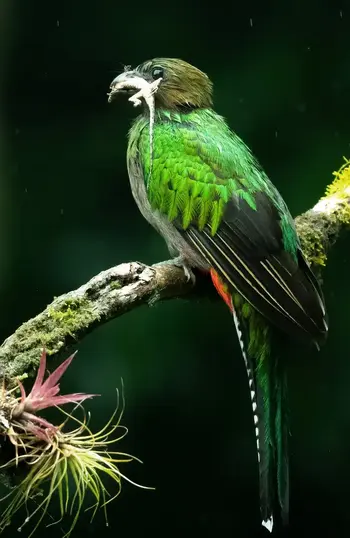
Hummingbird Heaven: 20+ Species at the Feeders
Hummingbird diversity is especially high, with around two dozen species frequenting the gardens, flowering shrubs, and dedicated feeders near the lodge buildings. Commonly seen species include the Talamanca hummingbird, scintillant hummingbird, lesser violetear, and violet sabrewing. Other highland specialties such as flame-colored tanagers, chlorophonias, and trogons are also frequently observed. Bird blinds and viewing decks make it possible for guests with limited mobility to enjoy excellent birding without venturing far from their rooms.
Photographer Tips: Blinds, Ridge Lines & Nest Sites
Several bird blinds with feeding stations and natural backdrops are positioned around the property, offering excellent opportunities for photographers to capture close-range and bird-in-flight (BIF) shots of a wide variety of species. These setups are especially useful for those aiming to document the region’s hummingbirds, tanagers, and quetzals. For the purists who prefer to observe natural behaviors in wild settings, Mount Totumas also delivers. Old-growth, dead trees provide ideal nesting cavities, within the soft decaying trunks, for resplendent quetzals. Parent quetzals can often be observed making frequent trips to and from their nests to feed their insatiable chicks during the breeding season. Three-wattled bellbirds, while more often heard than seen, are common on the property and can typically be located by following their distinctive calls, or with the help of a guide. The property’s varied topography allows for unique vantage points—photographers standing on ridgelines can look downslope directly into the forest canopy, making it possible to capture eye-level views of birds that would otherwise be hidden high above.
For serious birders, the surrounding habitats and adjoining national park trails offer deeper access to more elusive species and opportunities for extended day hikes with or without a guide.
Full Bird Species List
View the full Mount Totumas Bird Species List →Herping Mount Totumas

Target Species: Bothriechis nigroviridis, B. lateralis, Clelia clelia
While Mount Totumas is best known as a birding destination, the reserve is also of great interest to reptile and amphibian enthusiasts (a.k.a "herpers"). The cloud forests of the Talamanca Highlands are home to several rare and range-restricted species, including the highland palm pitvipers Bothriechis lateralis and Bothriechis nigroviridis. The latter is particularly elusive, but both species occur on the property and in the surrounding forest.
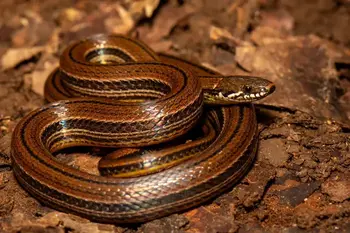
Guests are welcome to explore the trails unguided, day or night, a significant advantage for herpers who prefer to search for animals at their own pace and during the most productive hours after dark. The trails are well-maintained and offer access to a range of elevations, riparian areas, and forest types—ideal for targeting a variety of amphibians and reptiles. While wildlife is generally less abundant here than in the lowland rainforests of Panama, the cloud forest holds a different kind of appeal: endemic and montane species that cannot be found elsewhere. During the wet season, herping becomes especially productive, but even in the dry season, amphibians and reptiles can be found with effort and persistence.
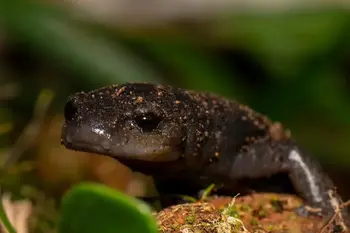
The herpetofauna of Mount Totumas includes a variety of montane specialists and elusive forest dwellers that are highly sought after by field herpetologists and photographers. Notable snake species documented on the property include the side-striped palm pitviper (Bothriechis lateralis), the rarely encountered black-speckled palm pitviper (Bothriechis nigroviridis), the mussurana or Central American indigo snake (Clelia clelia), and smaller colubrids such as Rhadinella godmani, Ninia psephota, Lampropeltis micropholis, and Geophis brachycephalus.
Reptile Species List
View A Partial Checklist of Reptiles Recorded at Mount Totumas →Amphibian Highlights: Glass Frogs & Giant Salamanders
The diverse amphibian community features species such as Craugastor podiciferus, Craugastor crassidigitus, Diasporus diastema, Isthmohyla rivularis, and the glass frog Espadarana prosoblepon. Salamanders are also present, including Bolitoglossa sombra, a large lungless species found in moist leaf litter and rotting wood, and somewhat common at the higher elevations of Mount Totumas. Reptile sightings may include high-elevation lizards like Sceloporus malachiticus and at least one species of Anolis, although identification may be uncertain. This mix of highland endemics, cryptic species, and rare finds makes Mount Totumas an especially compelling site for herpers looking to document the fauna of Panama’s Talamanca cloud forests.
View A Partial Checklist of Amphibians Recorded at Mount Totumas →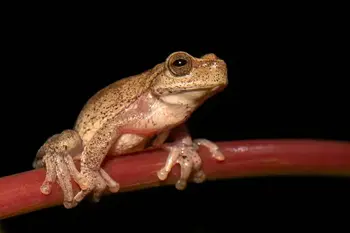
Because Mount Totumas is primarily known as a birding destination, its busiest season coincides with the relatively short nesting window of the resplendent quetzal, typically from March to mid April. In contrast, the wet season (Late May-November)—generally less popular with birders and casual vacationers—is the most productive time for finding reptiles and amphibians. As a result, herpers visiting during this time can provide valuable off-season income for the lodge, helping to support its year-round conservation efforts while also benefiting from optimal herping conditions and fewer crowds.
Mammals of Mount Totumas
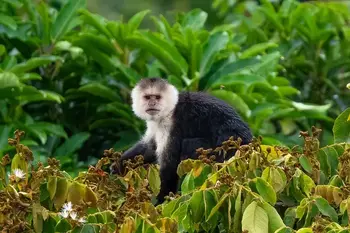
Monkey Troops & Canopy Mammals
Mount Totumas is home to a wide array of mammal species, thanks to its large size, forest cover, and direct connection to La Amistad International Park. Three species of monkeys—mantled howler monkeys, white-faced capuchins, and spider monkeys—are regularly seen on the property, with howlers and capuchins particularly easy to observe from the ridge-top vantage of the Bellbird Lodge.
Elusive Icons: Pumas, Tapirs & Jaguars on Camera Trap
Nocturnal mammals such as Virginia opossums, olingos, porcupines, and bats are commonly encountered during night walks, especially with the help of a guide. Camera traps placed around the property have captured images of pumas, tapirs, and even jaguars, though large cats are rarely seen in person. The presence of these apex predators is a strong indicator of ecosystem health and a testament to the value of protected buffer zones like Mount Totumas.
Guests who explore the trails—especially those with patience and a quiet approach—are often rewarded with sightings of mammals that would go unnoticed in more disturbed or developed landscapes.
View A Partial Checklist of Mammals Recorded at Mount Totumas →Accommodations

-
 Price: $130-260 USD per night, depending on room. Discounts may exist for longer stays.
Price: $130-260 USD per night, depending on room. Discounts may exist for longer stays.
-
 Beds: Most rooms have two beds and sleep 2-3 people, and a private cabin can sleep 7.
Beds: Most rooms have two beds and sleep 2-3 people, and a private cabin can sleep 7. -
 Check In/Out: Flexible depending on your arrival/departure times.
Check In/Out: Flexible depending on your arrival/departure times. -
 Safe, isolated property
Safe, isolated property
-
 Outlets for Electronics in rooms and shared kitchen and common/dining area.
Outlets for Electronics in rooms and shared kitchen and common/dining area.
-
 Wifi. Cell/data service available in the dining/common area of the Bellbird lodge (available to all guests).
Wifi. Cell/data service available in the dining/common area of the Bellbird lodge (available to all guests).
-
 Languages Spoken: English and Spanish
Languages Spoken: English and Spanish
-
 Meals: A shared full kitchen is available in the Coffee House lodge, with fridge and freezer space. Prepared meals, breakfast, lunch, and dinner, are available at the dining area in the Bellbird lodge (No a la carte option). The chef can accommodate dietary restrictions. Breakfast: free, Lunch: $12, Dinner: $22-24.
Meals: A shared full kitchen is available in the Coffee House lodge, with fridge and freezer space. Prepared meals, breakfast, lunch, and dinner, are available at the dining area in the Bellbird lodge (No a la carte option). The chef can accommodate dietary restrictions. Breakfast: free, Lunch: $12, Dinner: $22-24.
 Transportation services: A 4x4 vehicle is required to reach the lodge. A typical taxi or rental car will not be sufficient. The lodge can arrange ground transportation upon request (To/from David airport is $100 USD each way).
Transportation services: A 4x4 vehicle is required to reach the lodge. A typical taxi or rental car will not be sufficient. The lodge can arrange ground transportation upon request (To/from David airport is $100 USD each way).
 Bathroom: Private bathrooms in each room include shower (with hot water), sink, and toilet.
Bathroom: Private bathrooms in each room include shower (with hot water), sink, and toilet. Laundry: service available upon request for extra fee ($8-12).
Laundry: service available upon request for extra fee ($8-12).
Mount Totumas in 360°
Click and drag your mouse on the images below to change the view perspective
360° Full Virtual Tour of Mount Totumas Reserve
Trails of Mount Totumas Ecolodge and Cloud Forest Reserve

Mount Totumas features an extensive network of well-maintained trails that wind through over 30 kilometers of varied terrain, offering access to nearly every part of the 400-acre reserve. These trails are one of the lodge’s defining features, giving guests the freedom to explore diverse cloud forest habitats at their own pace, day or night. For wildlife enthusiasts—whether birders, herpers, or general naturalists—the trail system allows for quiet, low-impact exploration of some of Panama’s most biologically rich mid-elevation forest.
The trails range from wide, gently sloped paths that pass through regenerating secondary forest to steeper, narrower routes that ascend into more remote areas with older growth trees. Microhabitats change with elevation, slope, and proximity to water, providing excellent opportunities to observe different assemblages of flora and fauna. Some trails follow clear mountain streams lined with moss-covered rocks and dense understory, while others traverse ridgelines that offer sweeping views of La Amistad International Park and allow eye-level observation of canopy-dwelling birds and mammals.
Ridge‑Top Vistas & Canopy‐Level Birding Spots
Guests are free to hike unguided at any time—a significant advantage for herpetologists and photographers who rely on flexibility and quiet conditions. Trail signage is clear, and most routes begin within easy walking distance of the lodge buildings. Because the property’s elevation spans over 600 vertical meters, guests can explore a range of ecological zones in a single outing, often transitioning between habitats home to very different wildlife communities.
Freedom of 24 Hour Trail Access
For birders, the trail system gives access to nesting sites, fruiting trees, and calling grounds for sought-after species like quetzals, trogons, and bellbirds. Herpers benefit from the ability to cover ground at night with minimal safety concerns, especially in riparian zones and forest clearings where amphibians and snakes are most active. The freedom to walk trails independently after dark is a rare and valuable feature among ecolodges in the region.
Extended Treks to Hot Springs & Mount Totumas Summit
Trails also connect to nearby destinations such as the Los Pozos hot springs and, for more ambitious hikers, full-day treks into adjoining La Amistad International Park or up to the 2,630-meter summit of Mount Totumas itself. These longer hikes offer chances to visit remote homesteads, explore less-traveled wilderness, and encounter wildlife in increasingly undisturbed forest.
Tours of the Mount Totumas Cloud Forest Reserve
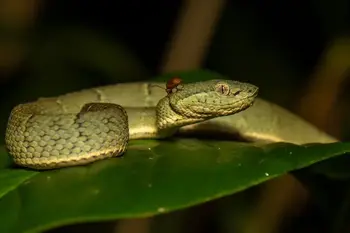
While visitors are free to explore Mount Totumas' trail system on their own, guided hikes offer a deeper understanding of the forest and significantly increase the chances of spotting elusive wildlife. Expert guides at the lodge are available for both half-day and full-day tours and are especially recommended for first-time visitors, wildlife photographers, and anyone with a specific interest in birdwatching or natural history.
Meet the Guides: Reinaldo & David
Mount Totumas’ lead guide, Reinaldo, is a certified naturalist with deep local knowledge and years of field experience. As a member of the local Indigenous community, he grew up exploring this landscape and brings an intimate familiarity with the region’s ecology. Fluent in English and Spanish, he excels at helping guests locate and identify rare species—from montane hummingbirds and hidden quetzal nests to cryptic frogs and calling bellbirds. His brother David, also a guide, offers additional availability during the busy season and can lead both day and night hikes.
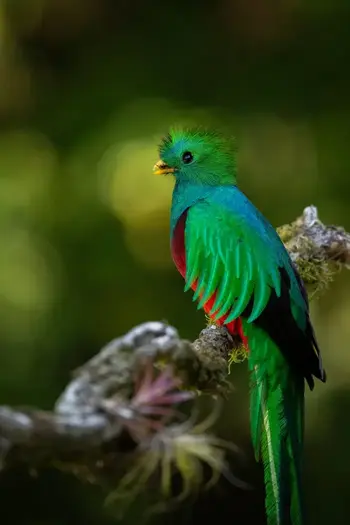
Guided tours are particularly beneficial for birders hoping to track down vocal but hard-to-spot species like the three-wattled bellbird, or for herpers targeting secretive snakes and amphibians hidden in dense understory or leaf litter. Guides also help guests interpret animal behaviors, habitat cues, and signs such as tracks, scat, and feeding damage—insights that can be easily overlooked during self-guided hikes.
Tour Pricing & How to Book in Advance
Tours are available to be booked on-site, but due to limited availability, it’s recommended that guests who know they’ll want guided hikes schedule at least some of their tours in advance. Rates are $60 for a half-day and $90 for a full-day tour, with flexibility based on interest and physical ability. Both daytime and nighttime hikes are available, and the guides are equipped to cater to a wide range of interests, whether focused on birds, reptiles, mammals, insects, or a general immersion in cloud forest ecology.
In a forest as complex and layered as the one surrounding Mount Totumas, a guide not only improves your chances of spotting wildlife but enhances the overall experience by offering a narrative that connects what you see with the broader ecological context. Whether you're hoping to photograph a rare bird at its nest, learn the call of a hidden frog, or follow fresh animal tracks along a mountain stream, guided hikes offer a rewarding and educational way to experience the reserve.
Mount Totumas staff went out of their way to support my specific interest in photographing highland pitvipers, particularly Bothriechis lateralis and Bothriechis nigroviridis. After I mentioned this interest to Jeffrey Dietrich, he passed the information to Reinaldo, the lodge’s lead guide, who in turn coordinated with the Mount Totumas coffee plantation workers. Reinaldo offered them a modest $5 reward for safely capturing any snakes they encountered in the coffee fields and bringing them to me for documentation. Over the course of my ten-day stay, the workers found two B. lateralis, which I was able to photograph before releasing them unharmed into the forest. The bounty was intentionally set at a level high enough to incentivize an alternative to fear-based killing of the snakes, while low enough to avoid the creation of any incentive to over-collect. This thoughtful, targeted effort reflects the lodge’s willingness to accommodate the goals of visiting naturalists and its practical, conservation-minded approach to managing human-wildlife interactions.
Mount Totumas Videos
9 YouTube videos from Mount Totumas. Press play, then press ![]() (or Shift+N) on the video player to move to next video and
(or Shift+N) on the video player to move to next video and ![]() (or Shif+P) to move back to the previous video. Click the
(or Shif+P) to move back to the previous video. Click the ![]() icon in the top right corner of the player to view list of all videos.
icon in the top right corner of the player to view list of all videos.
360 Video. Press play and use your mouse to scroll video. Adjust the image quality in the settings section.
Travel Guide to Mount Totumas
Flying to David: Fastest Route to the Highlands
Getting to Mount Totumas Ecolodge is relatively straightforward with a bit of advance planning, and most international travelers will begin their journey by flying into Panama City, Panama. From there, the most efficient way to reach the lodge is to take a domestic flight to the city of David, located in the western Panamanian province of Chiriquí on Panama’s Pacific coast. Copa Airlines, a major regional and international carrier, operates two daily flights between Panama City (Tocumen International Airport) and Enrique Malek International Airport in David. This option is highly recommended for visitors headed directly to Mount Totumas, as overland travel from Panama City can take seven hours or more.
4×4 Transfer: Costs, Road Conditions & Tips
Once in David, the most convenient and often most economical way to reach the ecolodge is to arrange private ground transportation through Mount Totumas staff. As of 2025, the cost for this service is $100 USD each way, with the drive taking approximately 1.5 to 2 hours. This includes the final segment of the trip, which involves traveling several miles up a steep, unpaved road that requires a high-clearance 4x4 vehicle. Regular taxis and most rental cars are not suitable for this stretch, and self-driving is not recommended unless you are familiar with rough mountain roads and equipped with a capable vehicle such as a Toyota Hilux or Suzuki Jimny.
On‑Site Amenities: Meals, Wi‑Fi & Guided Activities
Once at the lodge, guests will not need a vehicle, as Mount Totumas is a remote, self-contained destination. All meals are provided on-site, and there are no nearby towns or attractions within walking distance. The lodge’s trail network and optional guided tours offer plenty to explore without the need to travel beyond the property.
Continuing Your Trip: Shuttle Options to Boquete & Volcán
For travelers continuing their journey through western Panama, the lodge can also assist with arranging transportation to other destinations, including Boquete, Volcán, or rendezvous points for regional shuttles and transfers. These services make Mount Totumas an accessible and flexible stop whether it’s your primary destination or part of a broader itinerary.
❓Frequently Asked Questions (FAQs) About Mount Totumas
-
What makes Mount Totumas a unique destination for birdwatchers?
Mount Totumas sits at the ecological intersection of lowland and highland species, making it one of Panama’s most biodiverse birding sites. Over 230 species have been recorded, including the resplendent quetzal, three-wattled bellbird, and black-faced solitaire. But a checklist doesn’t capture the experience—our Mount Totumas 360° virtual tour, complete with naturally captured bird sounds, bring it vividly to life.
-
Is Mount Totumas suitable for herping and amphibian photography?
Absolutely. With night access to trails and proximity to pristine cloud forest, Mount Totumas is an ideal location for herpers targeting frogs, salamanders, and highland pitvipers such as Bothriechis nigroviridis and Bothriechis lateralis. We've documented several species on our natural history species pages, where you can learn how and where to find them. For immersive context, our virtual tour showcases key habitats.
-
What are the accommodations like at Mount Totumas?
The lodge offers a range of cabins and guesthouse rooms with comfort and sustainability in mind—solar power, flush toilets, and views of mist-covered ridgelines. You can preview the experience in our Mount Totumas accommodations section or in the 360 virtual tours for the Coffee House, Bellbird Lodge, or the Treehouse. The gardens, balconies, and proximity to trails make staying here a full wildlife immersion.
-
How do you get to Mount Totumas Ecolodge?
Mount Totumas is accessed via a 4x4 road near the town of Volcán in western Panama’s Chiriquí Province. The Mount Totumas lodge can arrange ground transportation fron anywhere in Chiriquí, including the David airport. While it’s remote, the journey is part of the experience—passing through farmland, forest, and cloud-covered ridges. The travel section gives specific travel information for travel to Mount Totumas, and our Panama travel guide outlines multiple route options, arrival timing, and tips for travelers with gear.
-
What kind of wildlife can I expect to see around Mount Totumas?
From quetzals and bellbirds to olingos and side-striped palm pitvipers, the lodge is surrounded by species that make their homes in the highland cloud forest. Our guests often say the sightings begin before breakfast. For a visual introduction, our Mount Totumas photo gallery and 360° videos capture what words alone can’t.
-
Can I explore the trails on my own, or do I need a guide?
Both options are available. Guests have 24/7 access to well-marked trails, with maps provided for self-guided exploration. For deeper insight, guided walks can be arranged. Our 360 virtual tour gives you an immersive preview of the terrain and trail difficulty before you even arrive.
-
What’s the best time of year to visit Mount Totumas for wildlife?
Wildlife is abundant year-round, but bird activity peaks from January to April. The dry season (December–April) offers the best trail conditions and sunlight for birding and photography. The nesting season of the resplendent quetzal (March through mid April)is the best time to view these birds. From my own personal experience at Mount Totumas, the first two weeks of April were ideal for viewing quetzals, as they already had hatchlings and could be observed making frequent trips to and from their nests to feed their growing chicks.
The wet season (May to November), on the other hand, is the best time for herping. The rains bring out the amphibians as well as the animals (snakes) that prey upon them. For help timing your trip, dive into the comprehensive Panama travel guide for general recommendations and discussions on climate and weather.
-
What are meals like at Mount Totumas?
Meals at Mount Totumas are unexpectedly exceptional for a remote lodge. From personal experience, dinners are often multi-course and include fresh produce grown in the on-site gardens. Dietary restrictions are handled with care, and the staff even accommodated a guest at our table with a complex vegan-gluten-free diet. Dining takes place in a rustic lodge with views of the forest canopy—every morning, I watched hummingbirds and sometimes monkeys while drinking locally sourced coffee.
-
What should I pack for a stay at Mount Totumas?
I recommend packing as if you’re heading on a high-elevation trek: layers for cool mornings, breathable rain gear, and rubber boots for trail use. Flashlights with red mode, a small dry bag, and insect repellent (though bugs are minimal) are also essential. For photographers and herpers, macro lenses and headlamps are a must.
During the dry season (December through April), trail runners or hiking boots should be sufficient on most days. Water resistent hiking boots will likely be sufficient even on wet days, and rubber boots will likely not be necessary for most hikers. However, travelers visiting in the wet season, or herpers who like to hike through creeks will want to bring rubber boots. For a more general discussion, visit our comprehensive Panama Travel Guide.
-
Can you explore Mount Totumas trails at night?
Yes—this is one of the rare cloud forest lodges in Panama that permits guests to access trails independently at night. In fact, this website EcoNaturalist.com is designed to be a collection of ecolodges that cater to herpers and other wildlife enthusiasts who need freedom to access the trails at night and without the need for a guide. Mount Totumas was hand picked by me, the author, largely due to how well they accommodate eco naturalists.
I’ve found the best reptile and amphibian activity on warm, foggy evenings just before or after light rain. Bring a headlamp and move slowly; you’re likely to spot frogs, salamanders, or highland snakes near streambeds and forest edges.
